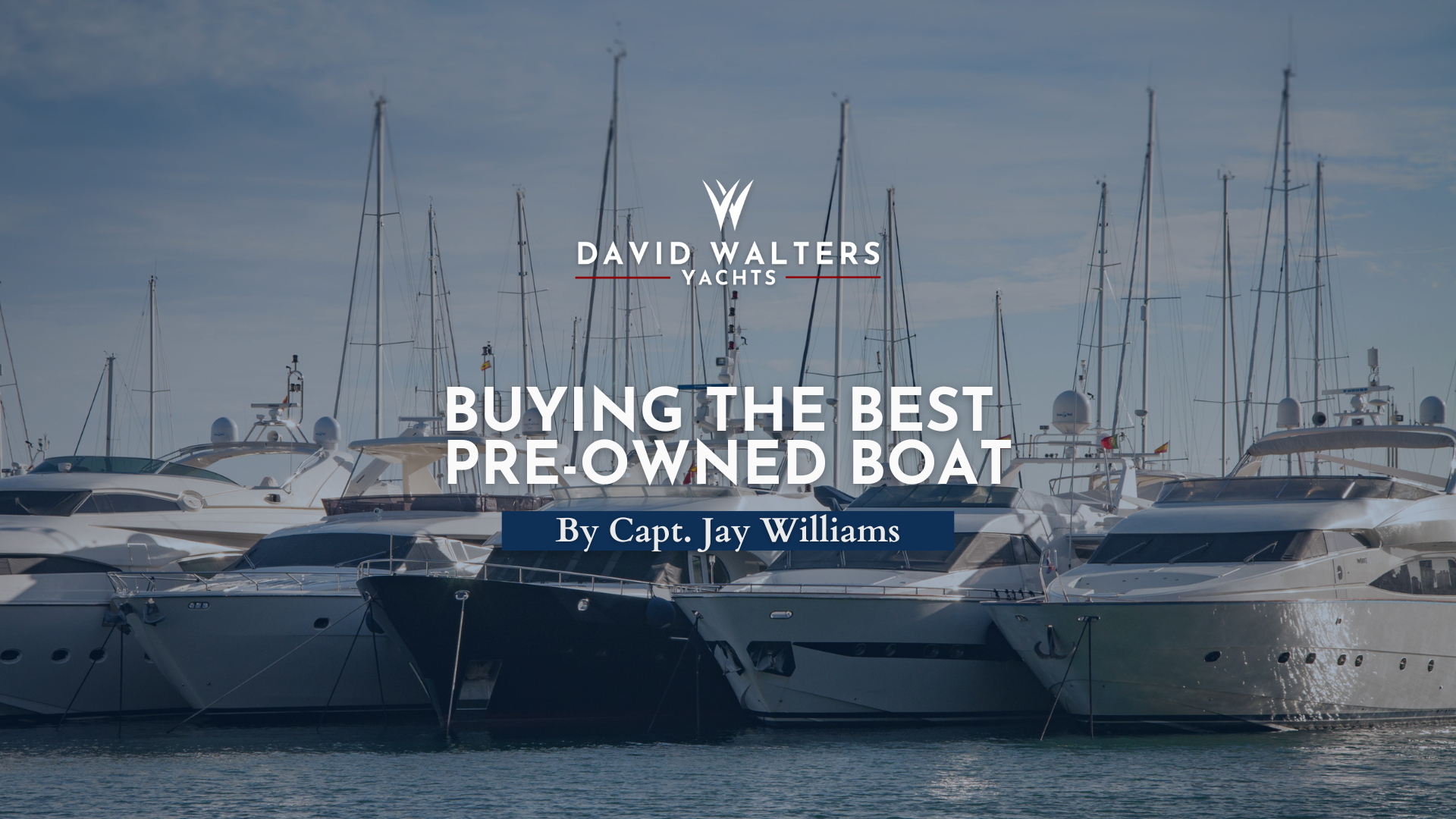Boat Buying Tips by Captain Jay Williams
 The journey to buying your cruising boat is every bit as thrilling—and daunting—as casting off the lines for the first time. That’s why having someone like Captain Jay Williams in your corner makes all the difference. With a lifetime on the water, from running liveaboard dive vessels in the Bahamas to managing new builds in Italy and overseeing complex yacht projects worldwide, Jay brings uncommon technical expertise, calm leadership, and a deep commitment to his clients' best interests. His hands-on experience, problem-solving skill, and ethical approach ensure your purchase process is not only efficient and well-managed but also genuinely enjoyable as you take the next step toward your dream.
The journey to buying your cruising boat is every bit as thrilling—and daunting—as casting off the lines for the first time. That’s why having someone like Captain Jay Williams in your corner makes all the difference. With a lifetime on the water, from running liveaboard dive vessels in the Bahamas to managing new builds in Italy and overseeing complex yacht projects worldwide, Jay brings uncommon technical expertise, calm leadership, and a deep commitment to his clients' best interests. His hands-on experience, problem-solving skill, and ethical approach ensure your purchase process is not only efficient and well-managed but also genuinely enjoyable as you take the next step toward your dream.
Captain Jay Williams
(305) 788-1121
About Jay Williams
Get Your Dream Underway
We all see the pictures of the cruising boats, anchored in some empty bay with crystal clear blue water, and the boat’s shadow sharply outlined in the perfect sand. You’ve spent too many nights cruising listings and reading forums; your life has been ruled by YouTube videos of others who have achieved your dream. Now it’s time. You’ve figured out what kind of boat you want, set a budget, and are ready to buy. In many ways, the decision to go ahead and buy that boat is as consequential as the decision to cast off the lines and leave on a cruise.
Captain Jay’s Tip:
Buying a pre-owned boat can be daunting. It’s similar to buying a house, with some critical differences in how the paperwork functions. Having an experienced yacht broker in your corner can dramatically ease the process; as professionals in the field, we know what to expect. A broker can help you navigate the pitfalls of the contract process and avoid some of the mistakes people often make.
We’ll do another presentation on what boats are best suited for their purpose; for this article, let’s assume you’ve already decided on the type of boat and your budget for the purchase.
Showings and Contract
Looking at the boat
For showing days, it’s best to be prepared. Wear good, high-traction shoes that can be easily removed; many owners prohibit shoes on board their boats. Leave the leather-soled dress shoes at home. Wear clothing that won’t be ruined by a dive into a boat bilge to look at plumbing or an excursion into an engine room.
Captain Jay’s Tip:
On the showing day, bring a snack and a water bottle. Walking marina docks, or going up and down ladders in a boat yard, can be surprisingly hard work. None of us makes the best decisions when we’re hungry and thirsty. Don’t look at more than 2-3 boats in a day; they’ll all blur together.
Things to look for
Use all your senses when you’re on the boat. How does the deck feel under your feet? Does the boat smell good inside? (If it’s been closed up for a while, any boat will get musty, give it a chance to air out). Try out the seating. Are you comfortable aboard? How are the ladders or stairs?
You can learn a lot through observation. There’s tremendous variability in owner behavior. Look for signs of neglected maintenance, such as oil collecting in the bilge. Also, look for evidence that professional work has been done. Pros don’t drill visible holes and string wires around; they conceal them correctly behind paneling and inside wiring runs. A professional repair tech won’t ever leave a mess behind. Ask for maintenance records. For larger boats, look for the certification date on the engine fire extinguishers and life raft, which will indicate how diligent the owner has been.
Captain Jay’s Tip:
Take a hard look around windows and portholes. Is there evidence that water has been coming into the interior of the boat? If the finish around the windows is damaged, especially at the bottom of the window frame, the boat has been leaking for a while. Look below that leak. What has been damaged? A cushion? Electronics? Do the same for any deck hatches. If something is leaking, you’ll need to address that leak as soon as possible after purchase.
The Deal
You’ve found the boat. It meets the criteria, things seem good inside and out, and it will be right for the cruising you want to do. Congratulations! This is where things get complicated. It’s also where a good broker earns their commission.
Making an Offer
When it’s time to make an offer, your broker will present you with a purchase and sale agreement to sign. These are often e-signable, rather than a paper contract. You and the broker will discuss the offer amount and the items you believe should be addressed within the offer. For instance, if the boat needs a 1000-hour engine service, you might want to make an offer that is reduced by the cost of that service.
This is also the point where you’ll make some decisions with your broker about the milestones of the deal: Acceptance of Offer, Acceptance of Vessel, and Closing. These can be adjusted as needed to address scheduling challenges, but they form the framework of the deal.
Captain Jay’s Tip:
Include everything you know that you’ll want to fix in the offer amount. Take the time to assess the costs you’ll incur by repairing these items. It can be challenging to obtain an estimate for repairs on a boat you don’t own yet. Work with your broker to craft this offer using their contact network to determine repair costs.
Deposits
The standard deposit is 10% of the offered price for the boat. The contract is not fully executed until the brokerage has confirmed receipt of these funds. It’s most common to wire the money. Here at DWY, we have several security measures in place to protect the funds being transferred.
The deposit funds are deposited into the brokerage escrow account and held until the deal is closed.
Counter Offers
The seller will likely counter your original offer. It’s common to go through 1-3 rounds of offer and counteroffer until you reach Acceptance, where both parties agree upon a price. At this point, the Purchase and Sale Agreement will be reissued for signature by all parties with the negotiated price updated.
Warranty of Title
As you head for the survey, the documentation agent will pursue a Warranty of Title, checking for outstanding liens and other challenges in the boat’s history. At David Walters Yachts, we use an in-house documentation agent who handles the majority of our deals. From this point forward, behind the scenes, the documentation agent will be filing the paperwork and sending you various things to sign.
The Survey
The survey is a condition assessment of the entire boat by a professional, licensed inspector. In addition, for a sailboat, you will likely want a rig survey by a professional rig shop. At the same time, for higher horsepower engines, you should engage an experienced mechanic who specializes in those engines. Each inspecting party will provide a written report.

Surveyors
- The choice of the surveyor is 100% the buyer’s. You should make contact with surveyors yourself and ask questions about the type or brand of boat and what their experience is with it.
- It seems most straightforward to ask the brokerage to recommend a surveyor; ethically, all we can do is provide a list of surveyors in the area without making a recommendation.
- There are two websites you should visit: Society of Accredited Marine Surveyors: https://marinesurvey.org/ and National Association of Marine Surveyors https://www.namsglobal.org/ to find a surveyor in your area.
- Once you have selected a surveyor, you, your broker, and the surveyor will discuss survey date availability. Once you have a set of dates nailed down, the broker(s) will coordinate.
- You and your broker will need to select a boatyard for the survey and schedule it accordingly. The yard will require your information and a credit authorization form on file before scheduling.
Captain Jay’s Tip:
Remember, the surveyor, mechanical inspector, and rigging inspector all work for you. You will pay them directly (most still like a paper check). Any report they produce will be your property and may be shared only with your permission.
Day of Survey and Sea Trial
This is a big day! Come prepared, dressed for boating. Bring a water bottle and a snack. Wear comfortable shoes, as there will be a lot of standing around. Expect this process to take all day. For boats over 50’, the survey can take place over 2-3 days for full diligence. You’ll probably only need to be physically there for the day of the sea trial.
If the boat is in the water, the surveyor will perform a “haul and hang” procedure: you’ll travel to a boatyard, where they will lift the boat, keeping it in the straps so the surveyor can inspect the hull and running gear. Either before or after the haul out, you’ll do the sea trial.
If the boat is already out of the water, it’s likely the surveyor will come down and complete the out-of-water portion beforehand.
Sea Trial
This will probably be your first time seeing the boat in action. The surveyor will put it through its paces, turning on every possible system and light and testing them out. If you have a mechanic aboard, they will provide instructions to the captain on running speeds to verify that the prop(s) are correct and the engine(s) are running at full load. If it’s a sailing vessel, the sails will be raised and lowered. Ask questions: you have access to people who know a lot about boats. Keep track of things you notice that are wrong; it’s valuable to compare with the survey report.

Survey Day Costs
- Surveyor
- Rig Surveyor (sail)
- Engine Inspector
- Shipyard, either to launch for survey or to haul and hang
All businesses involved in the survey will want to be paid at the time of service.
Captain Jay’s Tip:
Head up to the boat yard office to pay while the hull is being tapped by the surveyor. Most yards have a “no cash, no splash” policy for surveys. If you have a receipt in hand, when the surveyor is done, you can get the boat back in the water right away.
Safety Tip:
During the haul and hang, the boat is often supported only by the straps on the lift. Some of the more safety-focused yards will put blocks under the keel and lower the boat onto them to take most of the weight. Particularly if they didn’t use blocks, be very careful about being under the boat while it’s hanging. Note: it’s very common to schedule haul and hangs during lunch hour, so the crew might not be around during survey. Use good judgment.
Report of Survey
Your surveyor and other inspectors will all produce reports of the survey after the sea trial day. They usually take 24-72 hours to create. With larger yachts, these reports can run into hundreds of pages. A good survey is highly detailed. It will also include an appraisal of the boat. At the end, the report will have a “recommendations” section.
Your insurer will need a copy of this survey, and the recommendations section will drive their requirements. For instance, if the survey report lists frozen through-hull valves, your insurer may require them to be replaced after purchase.
Survey Allowance
This is the next negotiating step in the deal. You’ll want to assess the big things, like the frozen through-hull valves we talked about, that your insurer will want you to take care of, as well as any significant deficiency they found, like delamination in the deck or hull. You and your broker will craft a survey allowance, a discount from the boat purchase price, to address these things. You and the seller (through the broker(s)) will have a second round of counter offers. Once you settle on a price, we head towards Acceptance of Vessel.
Captain Jay’s Tip:
Remember, the seller has the option to repair the things on the survey allowance list rather than grant the allowance. It’s important not to “nickel and dime” the allowance to use it as a further discount tool.
Moving Toward Closing
Acceptance of Vessel
Here’s where it gets real. When you sign the Acceptance of Vessel, your deposit ceases to be refundable except in extreme circumstances. You should not sign the Acceptance of Vessel unless you have already completed all negotiations for the survey allowance and are ready to purchase the boat. Once you’ve signed the Acceptance of Vessel, you are moving towards closing.
Insurance
Once Acceptance of Vessel is signed, it’s time to confirm with your insurer and get the boat bound by them as of the closing date.
Captain Jay’s Tip:
Never leave a boat un-insured after the closing date. The universe loves to exploit an opening like that. It’s amazing how much more likely disasters are for boats that aren’t insured.
Closing Day Preparation
- The documentation agent will prepare a Buyer’s Closing Statement that lists the required funds to close the deal, including document fees.
- Wire funds to escrow at least 2-3 days before closing day. This gives the banks time to move the money and allows you and David Walters Yachts to catch any errors. Funds will remain in the David Walters Yachts escrow account and be disbursed to the seller via the involved brokerage houses from that account. Confirm that insurance is in place.
- You will have a good deal of paperwork to sign. It is primarily an e-signature; you should stay on top of it to keep things moving.
- You don’t need to be physically present at a closing, but if you can’t be, remember that the boat remains your responsibility going forward. Unless you’ve negotiated a stay at the marina or boat yard as part of the deal, you are on the hook for dockage and/or storage.
Captain Jay’s Tip:
Be careful with wire information; there are plenty of bad actors out there who are hoping to intercept a wire. Never use the words “wire transfer” in an email, and remember the steps we used to secure the deposit funds. You’ll be repeating them.
Congratulations! Remember that picture of the blue water? Now, get after that dream on your new boat!



.png)





LEAVE A COMMENT